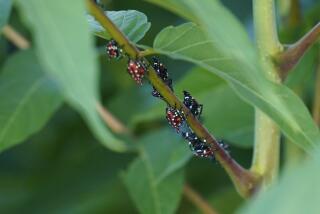These baby beetles are masters of deception. Here’s how they invade bees’ nests
Blister beetles are born with a mission: Infiltrate a bee’s nest. And they waste no time getting to work.
The larvae emerge from their eggs by the hundreds, climb the nearest blade of grass and coalesce into a wriggling ball of bodies and faux bee pheromones.
The beetles aim to deceive male bees by mimicking the chemical signals of females, which bury their eggs and pollen deep in the sand dunes of the insects’ shared habitat. When the fake pheromones lure a male bee in, the larvae reach out and grab on to him. Covered in parasites, the bee will transfer the larvae to a female during mating.
The female bee then carries the young blister beetles to her nest, where they get their reward: Tasty bee food.
It sounds like a daunting task, but one beetle species has managed to pull it off with two different kinds of bees: The pallid dune-digger bee of the Mojave Desert and the dune silver bee of the coastal dunes of Oregon.
Now researchers from UC Davis and UC Riverside have figured out how the Meloe franciscanus beetles do it.
Over millions of years, the beetles have synchronized their life cycles with that of their local bees, according to a study published this week in the Proceedings of the National Academy of Sciences.
“They’re absolutely dependent on the bee host,” said study leader Leslie Saul-Gershenz, an evolutionary ecologist at UC Davis.
In the late spring, dune-digging bees begin surfacing from their underground nests. (Unlike honeybees, which live in massive colonies, these insects live alone.)
At about the same time, the beetle larvae begin to execute their plan.
The larvae, called triungulins, form a bee-sized blob and work together to emit a chemical plume that, to a male bee, smells kind of like a potential mate. It’s not an exact match, but it’s close enough to entice a male to take a look.
In a series of field experiments, the researchers found that the Mojave’s digger bees are more attracted to beetle larvae from the Mojave, while the silver bees from Oregon preferred their local breed of beetle larvae.
To find out why, Saul-Gershenz spent five years gathering chemical “extracts” from male and female bees, as well as dissected bees’ heads and larval beetle body parts. She sent these and some live bees via FedEx to UC Riverside chemist Jocelyn Millar.
Millar’s painstaking chemical analysis revealed that beetles born in the California desert produce a different blend of attractive chemicals than did those from the Oregon coast.
The beetles also get a boost from the fierce competition among male bees to find a mate.
Male bees are known to form “mating balls,” in which up to 10 of the insects wrestle one another over a single female. Some of the males become so desperate that, despite the clear risk, they’ll engage with a sweet-smelling mass of beetle larvae.
“They’ll say, ‘Well it’s close enough,’ and they’ll make contact,” Saul-Gershenz said. “It’s not a great choice.”
Almost the entire mass of larvae instantly cling to the male bee like Velcro. Saul-Gershenz said she’s seen male bees fall to the ground under the weight of about 700-1,000 of the tiny insects.
“All the little larvae have their hands out,” she said. ”They have hooks on their little feet and they grab on. It’s just unbelievable how that evolved.”
Once infested, the male bee transfers the tiny parasites to the female when it mates (or attempts to mate) with her. The female then carries the larvae to her nest.
Over the next 11 months, the larvae feed on the bees’ precious pollen, nectar and, presumably, its offspring until they reemerge as fully grown beetles. (Because the nest is more than four feet underground, scientists aren’t sure if the beetles actually eat the nest’s lone egg or just all of its provisions.)
After their destructive youth, blister beetles live comparatively inauspicious adult lives. They cluster on plants, feed on leaves and wander around in the sand. They don’t bite.
Nor do the beetles overwhelm their host species. The larvae’s chemical signal merely approximates the bee pheromone, so it only manages to deceive a small subset of the population. The rest of the bees carry on without incident.
Saul-Gershenz said the relationship between bees and beetles shows how interconnected life on Earth can be.
“You can’t just protect things by breeding things separately and putting them back out,” she said. “Things are so interwoven together. It takes so many millions of years to develop.”







